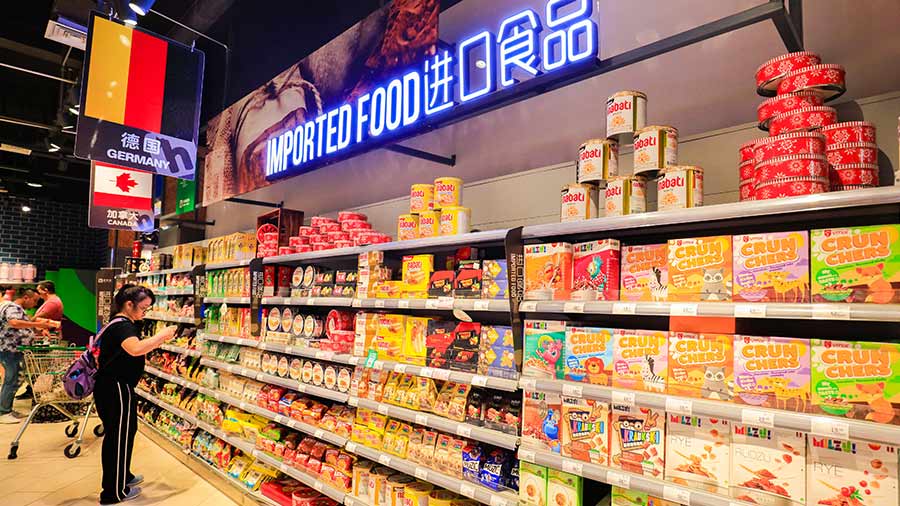March 31, 2022, Carrefour Beijing Zhongguancun Store, the largest flagship store of Carrefour in Asia, closed down.
All containers and shelves emptied with some red banners hanging in the store, written “Carrefour looks forward to meeting you in the future”. Except that no one knows when the future will come. And this sad exit is just a tip of the iceberg.
From 2018 to 2022, Carrefour closed 80 stores in China. This speed seems astonishing, but in the dusk of the whole supermarket industry, it is just a peak view of the sunset. In 2022, the "recession" of the industry has not rebounded at all. No matter whether it was supermarket giants such as Carrefour and Hualian, or Yonghui the once up-and-coming new comers, no one has been spared.
In 2020, 27 domestic supermarket enterprises closed at least 501 stores. The next year, the situation was even worse. The former king of supermarkets, China Resources Wanjia, closed more than 800 stores in one year.
The net profit of Gaoxin retail, which owns RT mart and Auchan, fell by 86% in the half year to the end of September 2021; Carrefour, which was acquired by Suning, suffered a loss of 770 million in the first half of 2021; After falling below 100 billion yuan in 2019, the sales of China Resources Vanguard will further shrink to 87.828 billion yuan in 2020.
Supermarket has been a low profit industry. Wal-Mart, the top in the industry, has a gross profit rate of 25% and a net profit rate of 5%. Compared with this most competitive level, the general supermarket usually only has a gross profit rate of 10% - 15%. After overhead deductions, the net profit rate is only 2.3%.

On the road of downhill, the time-honored entrepreneurs are not willing to walk down the card table easily. They struggled to fight back. RT mart and Carrefour are trying to "close big stores and change into small ones" -- closing big stores and trying the model of small and medium-sized supermarkets.
However, such a change will also fail. Rather than cutting costs, the new model loses the profit point of collecting rents from shops inside the supermarkets.
In the original model, the supermarket would charge the suppliers for shelf listing and display fees. If the goods were sold out, they would eat the price difference and rebate. If they could not be sold out, they would be returned to the suppliers, losing no money. These fees raised the cost of suppliers, and eventually reflected on retail price. In this way, compared with online channels, the competitiveness of offline goods is self-evident.
For e-commerce, what Internet giants bring is a dimension reduction attack of "Online and Offline".
Compared with the "dimension reduction attack", what worries offline supermarkets more is that their business is being incorporated into a larger business model by Internet giants - either as a Front-end Warehouse or as a Traffic Portal.
Even with supermarkets’ best endeavor, there has been no significant turn around. How to adapt to the new business world that is being re-defined by e-commerce, money burning commercial, insider trading and epidemic is a common topic faced by the supermarket industry.

The reason WKI chose to discuss about the sad facts about supermarket is because we understand why our brand sales representatives or managers all seemed to be obsessed to find distributors who can put their products on shelves of supermarkets. This has been a very conventional way of doing retail in China, and outdated as you can see from the data listed in the beginning of this article. This may still be the right way to sell to the Europe or US market where people embrace the supermarket as always, but certainly not here anymore, and defiantly not for new comers to the market.
The pandemic had been slowing the economy down and offline retail has been hit hard. Not only supermarkets, restaurants, cinema, the trend seems to be only the cellphone is still accessible to connect majority of consumers while social media being the affordable entertainment for everyone. This is an undeniable fact that consumers are more and more attached to their phones over going down the street to explore the shops. There are countless market research studied about the behaviors of young generation with their purchasing habit, all indicating that going online and connect through social media is the trendy way to go.
However, the other side of the coin, when the giants no longer hold its high horse bargaining power, the fees to gain a spot in the shop can be significantly lower the it used to be. Either way, supermarket giants may be falling, but offline retail shops won’t disappear. But no one should overlook the power and future of ecommerce hand-in-hand with social media.
Contact us to find out more.

All containers and shelves emptied with some red banners hanging in the store, written “Carrefour looks forward to meeting you in the future”. Except that no one knows when the future will come. And this sad exit is just a tip of the iceberg.
From 2018 to 2022, Carrefour closed 80 stores in China. This speed seems astonishing, but in the dusk of the whole supermarket industry, it is just a peak view of the sunset. In 2022, the "recession" of the industry has not rebounded at all. No matter whether it was supermarket giants such as Carrefour and Hualian, or Yonghui the once up-and-coming new comers, no one has been spared.
In 2020, 27 domestic supermarket enterprises closed at least 501 stores. The next year, the situation was even worse. The former king of supermarkets, China Resources Wanjia, closed more than 800 stores in one year.
The net profit of Gaoxin retail, which owns RT mart and Auchan, fell by 86% in the half year to the end of September 2021; Carrefour, which was acquired by Suning, suffered a loss of 770 million in the first half of 2021; After falling below 100 billion yuan in 2019, the sales of China Resources Vanguard will further shrink to 87.828 billion yuan in 2020.
Supermarket has been a low profit industry. Wal-Mart, the top in the industry, has a gross profit rate of 25% and a net profit rate of 5%. Compared with this most competitive level, the general supermarket usually only has a gross profit rate of 10% - 15%. After overhead deductions, the net profit rate is only 2.3%.

On the road of downhill, the time-honored entrepreneurs are not willing to walk down the card table easily. They struggled to fight back. RT mart and Carrefour are trying to "close big stores and change into small ones" -- closing big stores and trying the model of small and medium-sized supermarkets.
However, such a change will also fail. Rather than cutting costs, the new model loses the profit point of collecting rents from shops inside the supermarkets.
In the original model, the supermarket would charge the suppliers for shelf listing and display fees. If the goods were sold out, they would eat the price difference and rebate. If they could not be sold out, they would be returned to the suppliers, losing no money. These fees raised the cost of suppliers, and eventually reflected on retail price. In this way, compared with online channels, the competitiveness of offline goods is self-evident.
For e-commerce, what Internet giants bring is a dimension reduction attack of "Online and Offline".
Compared with the "dimension reduction attack", what worries offline supermarkets more is that their business is being incorporated into a larger business model by Internet giants - either as a Front-end Warehouse or as a Traffic Portal.
Even with supermarkets’ best endeavor, there has been no significant turn around. How to adapt to the new business world that is being re-defined by e-commerce, money burning commercial, insider trading and epidemic is a common topic faced by the supermarket industry.

The reason WKI chose to discuss about the sad facts about supermarket is because we understand why our brand sales representatives or managers all seemed to be obsessed to find distributors who can put their products on shelves of supermarkets. This has been a very conventional way of doing retail in China, and outdated as you can see from the data listed in the beginning of this article. This may still be the right way to sell to the Europe or US market where people embrace the supermarket as always, but certainly not here anymore, and defiantly not for new comers to the market.
The pandemic had been slowing the economy down and offline retail has been hit hard. Not only supermarkets, restaurants, cinema, the trend seems to be only the cellphone is still accessible to connect majority of consumers while social media being the affordable entertainment for everyone. This is an undeniable fact that consumers are more and more attached to their phones over going down the street to explore the shops. There are countless market research studied about the behaviors of young generation with their purchasing habit, all indicating that going online and connect through social media is the trendy way to go.
However, the other side of the coin, when the giants no longer hold its high horse bargaining power, the fees to gain a spot in the shop can be significantly lower the it used to be. Either way, supermarket giants may be falling, but offline retail shops won’t disappear. But no one should overlook the power and future of ecommerce hand-in-hand with social media.
Contact us to find out more.










